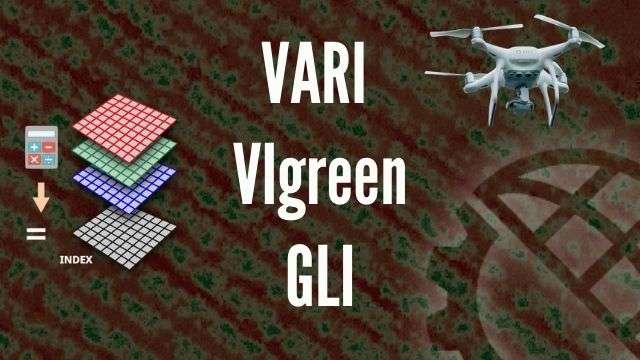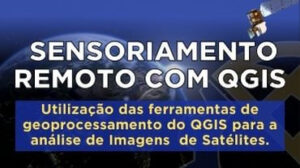VARI, VIgreen e GLI
É fato que trabalhar com sensores multiespectrais que captem faixas do infravermelho é muito interessante para análises e estudos sobre a vegetação e saúde das plantas utilizando índices como o NDVI. No entanto, nem sempre esses sensores são financeiramente acessíveis para quem está iniciando no mapeamento com drones.
Neste artigo, é apresentado alguns índices que usam apenas as bandas RGB (faixas do visível) de ortofotos de Drone ou de imagens de satélite. Esses índices são alternativas que podem ser aplicadas ao monitoramento da vegetação [1]. Confira as fórmulas matemáticas e algumas das aplicações para cada um deles:
- VARI – Visible Atmospherically Resistant Index
- VIgreen – Visible Atmospherically Resistant Indices Green
- GLI – Green Leaf Index
Visible Atmospherically Resistant Index (VARI)
O VARI é usado para estimar a fração de vegetação com o uma sensibilidade mínima aos efeitos da atmosféricos [2][3][4], onde a banda azul na equação 1 é para minimizar os efeitos atmosféricos [5].
Fórmula:
(1) ![]()
Aplicações:
- Estimar a fração de vegetação com um erro de pelo menos 10% [2].
- Detectar mudanças devido à acumulação de biomassa e é sensível à quantidade de clorofila perdida [6].
- Computar o índice de potencial de combustão, usando dados de um espectrômetro para monitorar índices de folhagem por área (Leaf Area Index – LAI) [7].
Visible Atmospherically Resistant Indices Green (VIgreen)
O VIgreen utiliza basicamente as bandas verde e vermelho [8][9][2].
Fórmula:
(2) ![]()
Aplicações:
- Interpretar a cobertura do solo e identificar vegetação verde, solo, água ou neve com base em seu valor [1].
- Detectar mudanças fenológicas e degradação florestal em florestas tropicais [10].
- Verificar mudanças de estação do ano [11].
Green Leaf Index (GLI)
O GLI foi criado originalmente para determinar o impacto de plantio de trigo. Se o valor for negativo, ele representa o solo ou vegetação sem vida, mas se o valor for positivo, ele corresponde a folhas verdes [12].
Fórmula:
(3) ![]()
Aplicações:
- Determinar clorofila em folhas de arroz [13]
- Diferenciar vegetação de não vegetação (assistir vídeo)
- Detectar a doenças em árvores [14]
Mais dicas:
Aprenda mais sobre Sensoriamento Remoto no QGIS:
Processe imagens de Drone em Softwares Livres:
Saiba como calcular facilmente esses índices com o plugin LFTools:
REFERÊNCIAS:
[1] Eng, L. S., Ismail, R., Hashim, W., & Baharum, A. (2019). The use of VARI, GLI, and VIgreen formulas in detecting vegetation in aerial images. International Journal of Technology, 10(7), 1385-1394.
[2] Gitelson, A.A., Kaufman, Y.J., Stark, R., Rundquist, D., 2002. Novel Algorithms for Remote Estimation of Vegetation Fraction. Remote Sensing of Environment, Volume 80(1), pp. 76–87
[3] Mokarram, M., Boloorani, A.D., Hojati, M., 2016. Relationship between Land Cover and Vegetation Indices. Case Study: Eghlid Plain, Fars Province, Iran. European Journal of Geography, Volume 7(2), pp. 48–60
[4] Mokarram, M., Hojjati, M., Roshan, G., Negahban, S., 2015. Modeling the Behavior of Vegetation Indices in the Salt Dome of Korsia in North-East of Darab, Fars, Iran. Modeling Earth Systems and Environment, Volume 1(27), pp. 1–9
[5] Schneider, P., Roberts, D.A., Kyriakidis, P.C., 2008. A VARI-based Relative Greenness from MODIS Data for Computing the Fire Potential Index. Remote Sensing of Environment, Volume 112(3), pp. 1151–1167
[6] Viña, A., Gitelson, A.A., Rundquist, D.C., Keydan, G., Leavitt, B., Schepers, J., 2004. Monitoring Maize ( L.) Phenology with Remote Sensing. Agronomy Journal, Volume 96(4), pp. 1139–1147
[7] Mckinnon, T., Hoff, P., 2017. Comparing RGB-Based Vegetation Indices with NDVI for Drone Based Agricultural Sensing. Agribotix.Com, Volume 21(17), pp. 1–8
[8] Motohka, T., Nasahara, K.N., Oguma, H., Tsuchida, S., 2010. Applicability of Green-red Vegetation Index for Remote Sensing of Vegetation Phenology. Remote Sensing, Volume 2(10), pp. 2369–2387
[9] Ahamed, T., Tian, L., Zhang, Y., Ting, K.C., 2011. A Review of Remote Sensing Methods for Biomass Feedstock Production. Biomass and Bioenergy, Volume 35(7), pp. 2455–2469
[10] Nagai, S., Ishii, R., Suhaili, A. Bin Suhaili, Kobayashi, H., Matsuoka, M., Ichie., Motohka, T., Kendawang, J.J., Suzuki, R., 2014. Usability of Noise-free Daily Satellite-observed Green–red Vegetation Index Values for Monitoring Ecosystem Changes in Borneo. International Journal of Remote Sensing, Volume 35(23), pp. 7910–7926
[11] Muraoka, H., Noda, H.M., Nagai, S., Motohka, T., Saitoh, T.M., Nasahara, K.N., Saigusa, N., 2013. Spectral Vegetation Indices as the Indicator of Canopy Photosynthetic Productivity in a Deciduous Broadleaf Forest. Journal of Plant Ecology, Volume 6(5), pp. 393–407
[12] Louhaichi, M., Borman, M.M., Johnson, D.E., 2001. Spatially Located Platform and Aerial Photography for Documentation of Grazing Impacts on Wheat. Geocarto International, Volume 16(1), pp. 65–70
[13] Yuliantika, G., Suprayogi, A., Sukmono, A., 2016. Analisis Pengunaan Saluran Visible untuk Estimasi Kandungan Klorofil Daun Pade dengan Citra Hymap. (Studi Kasus: Kabupaten Karawang, Jawa Barat). Jurnal Geodesi Undip, Volume 5(2), pp. 200–207
[14] Kim, S.R., Lee, W.K., Lim, C.H., Kim, M., Kafatos, M.C., Lee, S.H., Lee, S.S., 2018. Hyperspectral Analysis of Pine Wilt Disease to Determine an Optimal Detection Index. Forests, Volume 9(3), pp. 1–12





















